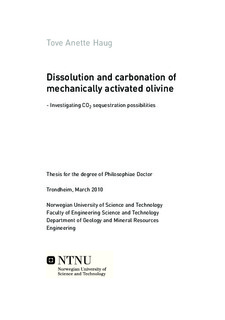| dc.contributor.advisor | Kleiv, Rolf Arne | nb_NO |
| dc.contributor.advisor | Munz, Ingrid Anne | nb_NO |
| dc.contributor.advisor | Sandvik, Knut Lyng | nb_NO |
| dc.contributor.author | Haug, Tove Anette | nb_NO |
| dc.date.accessioned | 2014-12-19T11:53:57Z | |
| dc.date.available | 2014-12-19T11:53:57Z | |
| dc.date.created | 2010-03-15 | nb_NO |
| dc.date.issued | 2010 | nb_NO |
| dc.identifier | 303780 | nb_NO |
| dc.identifier.isbn | 978-82-471-1960-0 | nb_NO |
| dc.identifier.uri | http://hdl.handle.net/11250/235863 | |
| dc.description.abstract | Mineral carbonation used for CO2 sequestration faces three main challenges: increasing the overall carbonation rate, handle large amounts of feedstock and products, and developing a practical process with commercially acceptable energy consumption.
High intensity milling, also called mechanical activation, has been found to increase the extraction rate of metals in the metallurgical industry. The focus of this PhD study has been the use of mechanical activation as a pre-treatment method within mineral carbonation as applied to CO2 sequestration. Olivine was chosen due to the availability of this mineral in Norway. Experiments were conducted to determine how mechanical activation changed the specific surface area, particle size distribution and the crystallinity; and to explore how milling conditions and material characteristics were correlated with increased dissolution rates and increased extent of carbonation. A planetary mill was used in all experiments in addition to a laboratory ball mill, a pilot scale Hicom mill and a pilot scale Szegvari attritor when mechanical activation was evaluated for implementation within mineral carbonation. Finally the energy consumption during milling was evaluated in the context of CO2 sequestration.
Over 60 olivine samples were prepared by milling including duplicates. Two dissolution experiments were performed, one at room conditions with 0.01 M HCl and one at 128 °C and 150 bar of CO2. The specific dissolution rates of mechanically activated samples increased up to three orders of magnitude compared to an unactivated reference sample. Crystallinity as calculated from X-ray diffractograms was the material parameter with the best correlation with the measured dissolution rates. Specific surface area was only correlated to dissolution rates for samples with relatively high crystallinity. The particle size distribution was not correlated with the measured dissolution rates. Neither the dissolution rates nor the material characteristics were directly correlated with the extent of carbonation observed in the direct carbonation experiments at 185 °C and 115 bar of CO2. The dissolution rates and crystallinity were partially correlated with the extent of carbonation obtained in the direct IV carbonation experiments performed at 128 °C and 150 bar of CO2. The interpretation was that in the 185 °C and 115 bar experiments, the extent of carbonation was mainly limited by precipitation kinetics of magnesite and silica, and was probably not limited by either the dissolution rate or olivine material properties.
The recognition of the importance of magnesite precipitation kinetics as an important factor of direct olivine carbonation has implications for the choice of pre-treatment methods and the design of the carbonation process used for CO2 sequestration. To optimize the direct carbonation reaction the dissolution rate can only be increased to a certain level. Then the magnesite precipitation rate has to be increased by manipulating the saturation indices, the reaction conditions and the precipitation mechanisms. At conditions where the precipitation kinetics are important, the least energy consuming milling alternative can be used since the additional energy does not contribute to the carbonation rate. The ball mill was shown to be a good option.
To take advantage of the observed increase in the dissolution rates, the carbonation process can be divided into two or more steps in an indirect carbonation process. The first step is dissolution and the second, and possibly subsequent steps, are precipitation of secondary minerals. Dividing dissolution and precipitation into two process steps introduces increased requirements for equipment, and the optimization of mass flows and saturation indices has to take into account unwanted precipitation and equilibrium restrictions. Indirect carbonation using mechanically activated samples with a high dissolution rate can be a viable option within CO2 sequestration, but the challenges of precipitation kinetics and energy consumption have yet to be solved. | nb_NO |
| dc.language | eng | nb_NO |
| dc.publisher | Norges teknisk-naturvitenskapelige universitet | nb_NO |
| dc.relation.ispartofseries | Doctoral Theses at NTNU, 1503-8181; 2010:5 | nb_NO |
| dc.relation.haspart | Haug, T.A.; Munz,, I.A.; Kihle, J; Kaszuba, J.P; Carey, J.W.. Energy intensive milling of olivine used for CO2 storage. Proceedings. International Conference on Accelerated Carbonation for Environmentaland Materials Engineering, Rome,: 83-92, 2008. | nb_NO |
| dc.relation.haspart | Haug, T.A.; Kleiv, R.A.; Munz, I.A.. Dissolution of mechanically activated olivine in hydrochloric acid - investigating leaching properties for carbonation purposes used for CO<sub>2</sub> storage. . | nb_NO |
| dc.relation.haspart | Haug, T.A.; Munz, I.A.; Kleiv, R.A; Kaszuba, J.P.; Carey, J.W.. Carbonation of mechanically activated olivine. . | nb_NO |
| dc.relation.haspart | Haug, T.A.; Kleiv, R.A.; Munz, I.A.. The importance of grinding solutions for mineral carbonation concepts. . | nb_NO |
| dc.subject | Mineral processing | en_GB |
| dc.subject | geochemistry | en_GB |
| dc.subject | olivine | en_GB |
| dc.subject | mechanical activation | en_GB |
| dc.subject | milling | en_GB |
| dc.subject | dissolution | en_GB |
| dc.subject | carbonation | en_GB |
| dc.subject | CO2 storage | en_GB |
| dc.subject | CO2 sequestration | en_GB |
| dc.title | Dissolution and carbonation of mechanically activated olivine-Investigating CO2 sequestration possibilities | nb_NO |
| dc.type | Doctoral thesis | nb_NO |
| dc.source.pagenumber | 243 | nb_NO |
| dc.contributor.department | Norges teknisk-naturvitenskapelige universitet, Fakultet for ingeniørvitenskap og teknologi, Institutt for geologi og bergteknikk | nb_NO |
| dc.description.degree | PhD i geologi og bergteknikk | nb_NO |
| dc.description.degree | PhD in Geology and Mineral Resources Engineering | en_GB |
